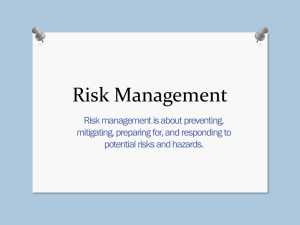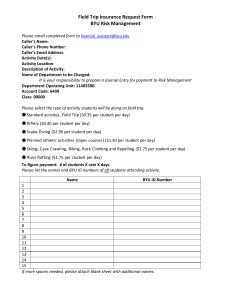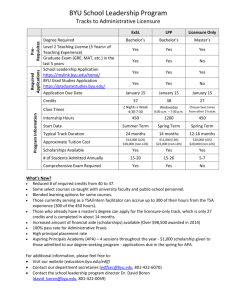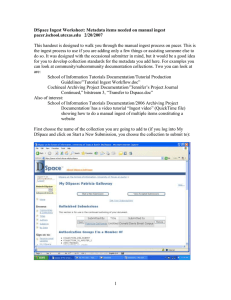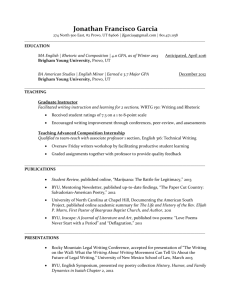BYU Digital Preservation Requirements
advertisement
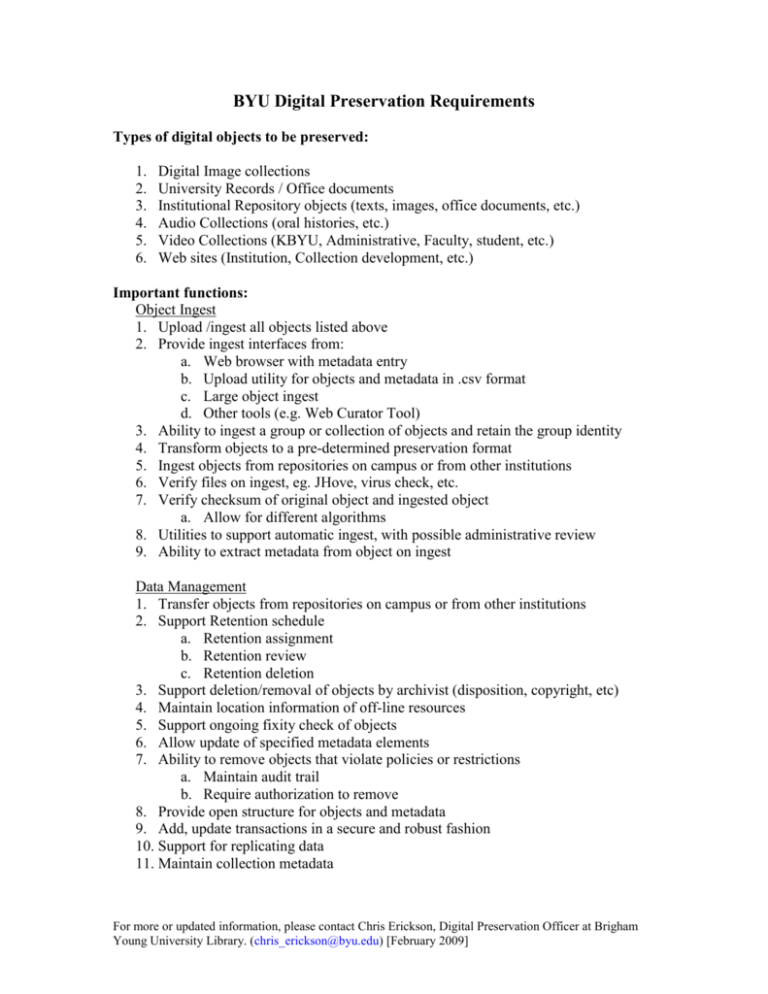
BYU Digital Preservation Requirements Types of digital objects to be preserved: 1. 2. 3. 4. 5. 6. Digital Image collections University Records / Office documents Institutional Repository objects (texts, images, office documents, etc.) Audio Collections (oral histories, etc.) Video Collections (KBYU, Administrative, Faculty, student, etc.) Web sites (Institution, Collection development, etc.) Important functions: Object Ingest 1. Upload /ingest all objects listed above 2. Provide ingest interfaces from: a. Web browser with metadata entry b. Upload utility for objects and metadata in .csv format c. Large object ingest d. Other tools (e.g. Web Curator Tool) 3. Ability to ingest a group or collection of objects and retain the group identity 4. Transform objects to a pre-determined preservation format 5. Ingest objects from repositories on campus or from other institutions 6. Verify files on ingest, eg. JHove, virus check, etc. 7. Verify checksum of original object and ingested object a. Allow for different algorithms 8. Utilities to support automatic ingest, with possible administrative review 9. Ability to extract metadata from object on ingest Data Management 1. Transfer objects from repositories on campus or from other institutions 2. Support Retention schedule a. Retention assignment b. Retention review c. Retention deletion 3. Support deletion/removal of objects by archivist (disposition, copyright, etc) 4. Maintain location information of off-line resources 5. Support ongoing fixity check of objects 6. Allow update of specified metadata elements 7. Ability to remove objects that violate policies or restrictions a. Maintain audit trail b. Require authorization to remove 8. Provide open structure for objects and metadata 9. Add, update transactions in a secure and robust fashion 10. Support for replicating data 11. Maintain collection metadata For more or updated information, please contact Chris Erickson, Digital Preservation Officer at Brigham Young University Library. (chris_erickson@byu.edu) [February 2009] Preservation Services 1. Transfer objects from repositories on campus or from other institutions 2. Maintain audit trail and log of all actions to objects a. Ability to view or provide reporting capability 3. Restrict system administrative functions by password a. Deletion b. Change access c. Change retention schedule 4. Utilities to identify and migrate formats 5. Utility to verify tape backups 6. Maintain permanent id that is web addressable 7. Ability to maintain different versions of documents 8. Ability to access objects and metadata outside of the software 9. Risk management features a. Report on objects by formats b. Ability to migrate formats 10. Ability to export content in standard formats without custom support 11. Provide access to original and transformed versions 12. Plan redundancy in system components 13. Follow Audit Checklist for Certifying Digital Repositories as relevant Access 1. Support access restrictions individually or in combination, by: a. User ID b. Group or university administrative position c. IP Address, or range (e.g. on campus only) d. Time period (e.g. no access for 25 years) e. Item / collection f. Copyright restriction 2. Ability to include preservation repository in standard search mechanisms 3. Ability to adjust user access to preservation objects Administrative Requirements 1. Provide interface for staff to configure options 2. Provide timely access to support personnel 3. Distribute releases and bug fixes in a regular process 4. Participate with an active users group a. Allow user input in the enhancement process b. Provide escrow of software, documentation, internal materials 5. Provide administrative reporting module 6. Provide open disclosure of methods to ingest, store, and maintain objects For more or updated information, please contact Chris Erickson, Digital Preservation Officer at Brigham Young University Library. (chris_erickson@byu.edu) [February 2009] Organization Requirements 1. Support a structure that allows for multiple partnerships or interfaces with BYU partnerships: a. BYU church partners: Church Consortium of Libraries and Archives (CCLA) i. BYU Provo ii. BYU Idaho iii. BYU Hawaii iv. LDS Business College v. CES Institutions b. BYU academic partnerships: i. Utah Academic Library Consortium (UALC) ii. Mountain West Digital Library (MWDL) iii. Greater Western Library Association (GWLA) 2. Allow interface with campus needs a. Library databases b. Classroom presentations c. Content-on-demand d. Blackboard 3. Ability to federate repositories Adhere to Standards and specifications 1. OAIS Reference Model 2. Trusted Digital Repositories TDR 3. Audit Checklist 4. Metadata: Support PREMIS, METS, MODS, DC, or modifications For more or updated information, please contact Chris Erickson, Digital Preservation Officer at Brigham Young University Library. (chris_erickson@byu.edu) [February 2009]
